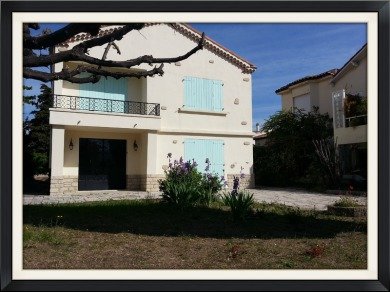Between individuals Marseille, France,13012
From individual to individual, without agency commission [tabgroup][tab title=”Advertisement”]
In residential area of Bois Luzy, between Saint-Barnabé and Montolivet, villa of 240 m².
on wooded and poolable land of 627 m².
On the same level : entrance, double living room, kitchen, wc, dressing room, cellar, large garage.
Upstairs: master suite, 2 bathrooms, wc, plenty of storage space and 4 bedrooms
one of which gives onto a terrace of 60 m².
This charming villa with 2 fireplaces and a marble staircase with wrought iron railing is close to all amenities and close to the Saint-Barnabé Metro and the A50 Motorway.
[/tab][tab title=”Brochure”] [calameo code=”003712955c6842bf4b659″ view=”slide” clickto=”embed” width=”550″ height=”356″ hidelinks=”1″]
[/tab][tab title=”Interactive photos”]
[/tab][tab title=”Situation”]
In 1930, Saint-Barnabé was “in the process of being joined by villas and houses to the large housing estate of Bois-Luzy, a magnificent domain acquired by the city, which has laid out beautiful avenues, but has not yet been able to make use of the beautiful and vast bastide. At the moment (1932), there is talk of installing an open-air school for weak, anemic, pre-tubercular girls”.
THE CASTLE OF BOIS-LUZY
The development of the Bois-Luzy estate, which initially covered 23 hectares with pine trees, vines, olive trees and fruit trees, dates back to the 17th century, with the family of Robert de Ruffi, who was a notary.
For 6 generations, it will remain in their family heritage.
The castle, in its present form, was built around 1850 by Mr. De Saint Alary. Its construction lasted several years. The mosaic of the central hall was executed by a team of Italian mosaicists, the same who made the mosaics of the Basilica of Notre Dame de la Garde, at that time.
The chandelier of the Basilica of Notre Dame de la Garde comes from the central hall of the Château de Bois-Luzy: it was the Marquise de Saint Alary who donated it when the château was sold.
The castle, of relatively modest dimensions, with 380 m2 of floor space, is built on 3 levels. It is surrounded by a large terrace of 2,000m2.
At the beginning of the 19th century, the Saint Alary family left the property. Several owners, merchants and shipowners, succeeded one another and transformed the property until its acquisition in 1925 by a bank. The Société Générale Foncière then divided it up and made it one of the largest housing estates in Marseille at the time, and the castle became the property of the city. Before 1939, it was converted into a rest house for the police
In 1940, it was requisitioned and successively received various occupants, including units of the German army.
In 1947, the city entrusted a non-profit association, which manages youth hostels, with the task of carrying out its social tourism activities.
In 1950, squatters invaded it and were only dislodged a few years later by the municipal services.
The castle then became what it is today: a youth hostel welcoming people from all walks of life who travel. Its frequentation oscillates between 12 000 and 15 000 nights per year.
[button size=”small” type=”primary or info or success or warning or banger or inverse” title=”Read more” link_url=”http://www.marseillemairie11-12.fr/votre-mairie/vos-quartiers/bois-luzy.html”]
[/tab][tab title=”Video”]
[/tab][/tabgroup]
More details on the Immovitrine International website

